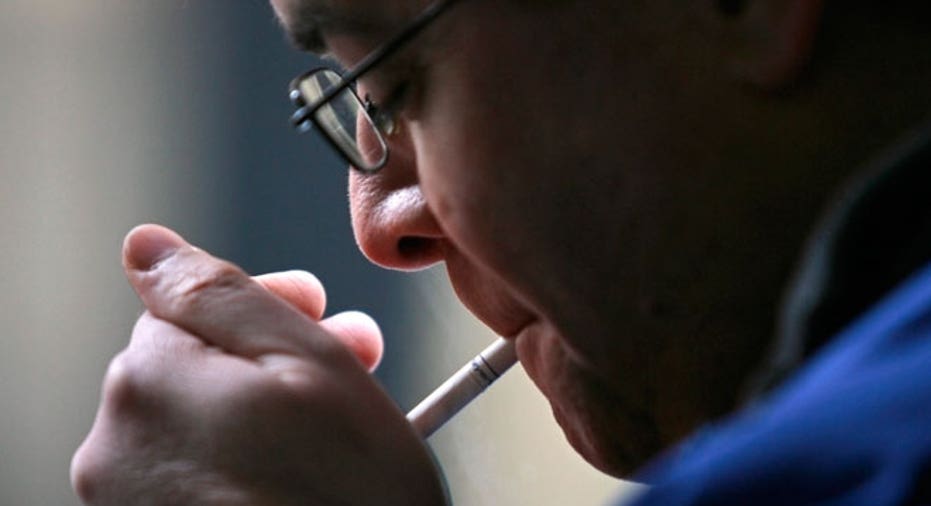Big Tobacco Pays States $6.5B Under Accord

Three of the biggest U.S. tobacco companies said on Monday they have paid a total of $6.5 billion this year to U.S. states, unchanged from 2011, under a 1998 national accord that obliges companies to help cover the health bills of ailing smokers.
Altria's Philip Morris paid $3.5 billion, but the Marlboro-maker is disputing $206 million of that sum and has put that money in escrow.
The national settlement, which involved most states, is designed to level the playing field between companies that signed it and those that did not. So the signing companies' payments are reduced by the amount of market share they lost to firms that did not participate in the settlement.
But the participating tobacco companies for years have argued the reductions were not big enough, and the major companies are putting the sums they dispute into escrow.
Reynolds American Inc, which makes Camels, paid $1.9 billion and has put the $469 million it disputes into escrow.
Lorillard, known for its Newport brand, said it paid $1.1 billion with $98 million of that amount put in escrow.
States, counties and cities have sold nearly $40 billion of bonds backed by the more than $200 billion in payments that cigarette makers agreed to make over time.
The National Association of Attorneys General last week estimated that the cigarette makers would pay the states about $6.1 billion, up from $6.03 billion last year. That figure does not include the disputed amounts and refers to all tobacco companies' payouts.
Last year, the top cigarette-makers, Philip Morris, Reynolds American and Lorillard, paid a net $5.649 billion versus $5.727 billion in 2012.
Yet the outlook for U.S. municipal tobacco bonds is only marginally better because cigarette sales are falling less steeply than anticipated and tobacco companies should pay the states slightly more under the national accord.
"We aren't out of the woods yet," said Richard Larkin, the Iselin, New Jersey-based director of credit analysis for HJ Sims, noting the risk that cigarette sales could decline more sharply next year.
Also, tobacco companies could win the right to keep some of the billions of dollars they argue they do not owe states.
The National Association of Attorneys General, whose members negotiated the 1998 settlement with cigarette makers, has said that the number of cigarettes sold fell just 2.9 percent versus an expected drop of 3.5 percent.
In 2010, cigarette sales fell much more steeply: 6.37 percent, according to Standard & Poor's Ratings Services. And in 2009, sales dropped 9.3 percent, it said.
CALIFORNIA, OHIO, VIRGINIA MIGHT GAIN
Unlike the overall tobacco bond sector, however, debt sold by three states should benefit from latest data.
That is because Ohio, California and Virginia all had to tap reserves last year to repay bondholders and this year's higher payments could help minimize how much those three states will have to tap reserves, according to analysts.
Ohio has sold $5.2 billion of tobacco bonds and last year it needed to withdraw about $8 million from reserves, he said. This year, Ohio might be able to avoid tapping reserves.
Virginia has sold more than $1 billion of tobacco bonds and this year Larkin said the withdrawal probably is going to be less than $1 million.
California has sold two issues of tobacco bonds. For a $4.4 billion issue, it had to withdraw about $7.7 million of reserves last year. This year, California probably will still have to use reserve funds to make payments on these bonds -- but only about $1.8 million, Larkin estimated.
California also sold another $3.1 billion of tobacco bonds, but that debt is also backed by state appropriations so its withdrawal of $5 million of reserves last year was not as worrisome, Larkin said.
But Blake Anderson, a managing director at Mesirow Financial's San Francisco-based high-yield group, cautioned that any market gains are not a sure thing for the tobacco bonds issued by these three states.
"Whether or not the market comes to recognize that is another factor entirely." That is because the market for tobacco bonds is so illiquid and the debt is so complex that considerable research is required to select winners and losers, the firm's analysts said.
So far this year, tobacco bonds largely have performed much like other high-yield municipal bonds, getting the benefit of some increased risk-taking by investors frustrated with lower yields offered by more secure investments, analysts say.
But the data are spotty because prices vary depending on the size of the block, and bid/ask spreads tend to be wide. That makes identifying trends more difficult.
Specific trades do, however, reveal the lofty yields that can be obtained with this kind of debt -- and some recently tighter spreads to the AAA-scale compiled by Municipal Market Data, part of Thomson Reuters.
For example, a $1 million block of California's Golden State Tobacco Securitization debt traded at a yield of 7.13 percent on April 16, according to EMMA, the data base set up by the Municipal Securities Rulemaking Board. The issue, which matures in 2033, has a 5 percent coupon. On Dec. 15, 2011, a $10 million block changed hands at an 8.06 percent yield.
A similar pattern was seen with some Virginia debt. A $1 million block of Virginia's tobacco bonds that mature in 2047 and carry a 5 percent coupon traded on April 13 at a 7.78 percent yield, according to EMMA. In contrast, an over $23 million block traded at an 8.635 percent yield on Dec. 7, 2011.



















